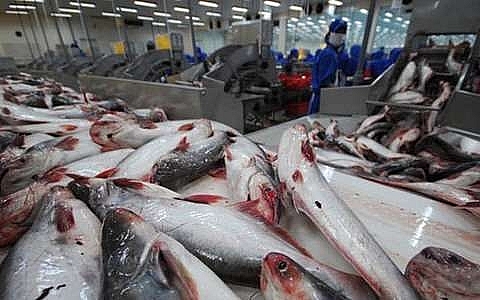Vietnam could face tra fish oversupply
 |
| Vietnam’s tra fish farmers could face oversupply problems this year due to rampant production. — Photo cafef.vn |
Many farmers have rushed to breed tra fish after prices increased steadily from the beginning of 2017 due to fingerling and raw materials shortages.
The situation may lead to oversupply of raw materials when farms step into the harvest season. The selling price of raw fish for factories could be reduced, the company said.
Farms could suffer great losses and stop breeding tra for the next season, meaning they would lack raw materials for the next crop, VDSC warned.
However, according to the firm, if the US-China trade war continues, Vietnam could increase its market share in the US, replacing Chinese tilapia that currently accounts for 40 per cent of all fish imports to the US.
Barriers to Vietnamese tra fish in the US market are likely to decrease. Vietnam has passed the US Department of Agriculture (USDA) field tests – the most important step in the assessment process established by the USADA’s Food Safety and Inspection Service (FSIS).
In addition, the preliminary anti-dumping tax on basa fish during the 14th administrative review period (POR 14) is significantly lower than that of POR 13. As a result, VDSC expects the tra fish export volume to the US market to increase sharply this year.
The Vietnam-EU Free Trade Agreement (EVFTA) may be approved early this year. If EVFTA is approved, the import tariff for frozen tra fish fillets will be reduced from the current rate of 5.5 per cent to zero within three years. The rate for processed tra fillets will be reduced from 7 per cent to zero within seven years. VDSC said demand for tra fish in the EU is expected to rise.
With the popularity of processed products in the US and EU markets, Vietnam has the potential to increase its profits from high-value products. The gross margin for the products is 22-25 per cent, higher than the margin of 12-16 per cent for frozen fillets.
The world population will exceed 8.5 billion people by 2030. As the natural fish supply worldwide is dwindling, the market share of farmed fish is expected to increase from 47 per cent in 2016 to 54 per cent in 2030. According to VDSC, this change presents a chance for tra producers like Vinh Hoan to expand production.
Vietnam’s Mekong Delta region has favourable ecological conditions for large-scale tra farming. The natural conditions combined with advanced farming technology will produce white-meat tra products, a favourite choice of consumers. Other major tra producers such as India, Bangladesh, Thailand and Indonesia produce low-value yellow-meat tra fish.
Vietnam’s export value of the fish was estimated at US$2.3 billion for 2018, higher than the $1.8 billion recorded in 2017, according to the Vietnam Association of Seafood Exporters and Producers.
What the stars mean:
★ Poor ★ ★ Promising ★★★ Good ★★★★ Very good ★★★★★ Exceptional
 Tag:
Tag:
Related Contents
Latest News
More News
- Businesses ramp up production as year-end orders surge (December 30, 2025 | 10:05)
- Vietjet chairwoman awarded Labour Hero title (December 29, 2025 | 13:06)
- How to unlock ESG value through green innovation (December 29, 2025 | 10:03)
- AI reshapes media and advertising industry (December 29, 2025 | 08:33)
- FPT and GELEX sign deal to develop blockchain tech for global markets (December 29, 2025 | 08:29)
- Vietnam’s GDP forecast to grow by 9 per cent in 2026 (December 29, 2025 | 08:29)
- Women entrepreneurs are key to Vietnam’s economic growth (December 29, 2025 | 08:00)
- Vietnam's top 500 value-creating enterprises announced (December 27, 2025 | 08:00)
- The PAN Group shaping a better future with ESG strategy (December 26, 2025 | 09:00)
- Masan Consumer officially lists on HSX, marking the next phase of value creation (December 25, 2025 | 13:20)























 Mobile Version
Mobile Version